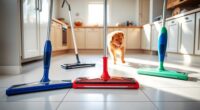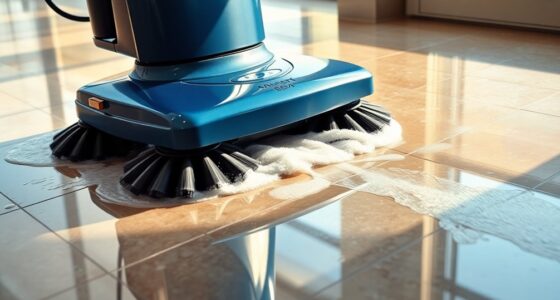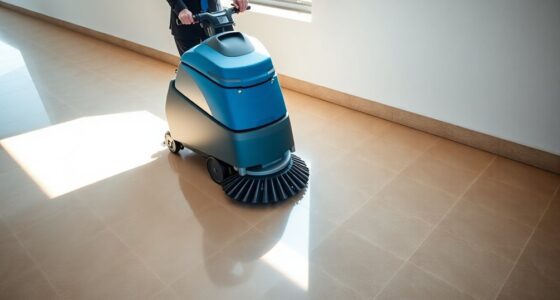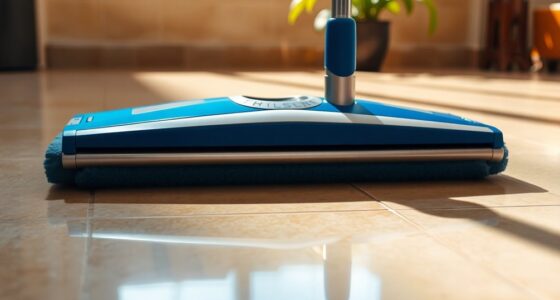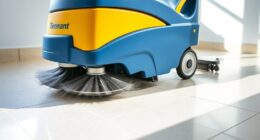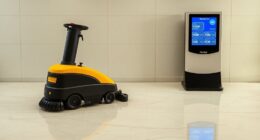If your floor scrubber is leaving streaks, it could be due to a worn-out squeegee blade, dirty components, or uneven floor surfaces. A damaged blade reduces water removal efficiency, while debris can clog the squeegee frame. Also, floors with low spots can hinder proper contact, resulting in uneven water pickup. Regular checks on your squeegee's adjustment and maintaining cleanliness can help. Discover more about these issues to achieve a streak-free shine.
Key Takeaways
- A dirty or damaged squeegee blade can reduce water removal efficiency, leading to streaks on the floor.
- Accumulation of dust and debris on the squeegee frame can hinder effective water pickup, causing streaks.
- Uneven floor surfaces or low spots can prevent proper squeegee contact, resulting in uneven water distribution and streak formation.
- Incorrect squeegee angle or deflection may impact cleaning performance, leading to streaks; regular adjustments are essential.
- Dilution levels of cleaning solutions affect performance; improper ratios can contribute to streaking on cleaned surfaces.
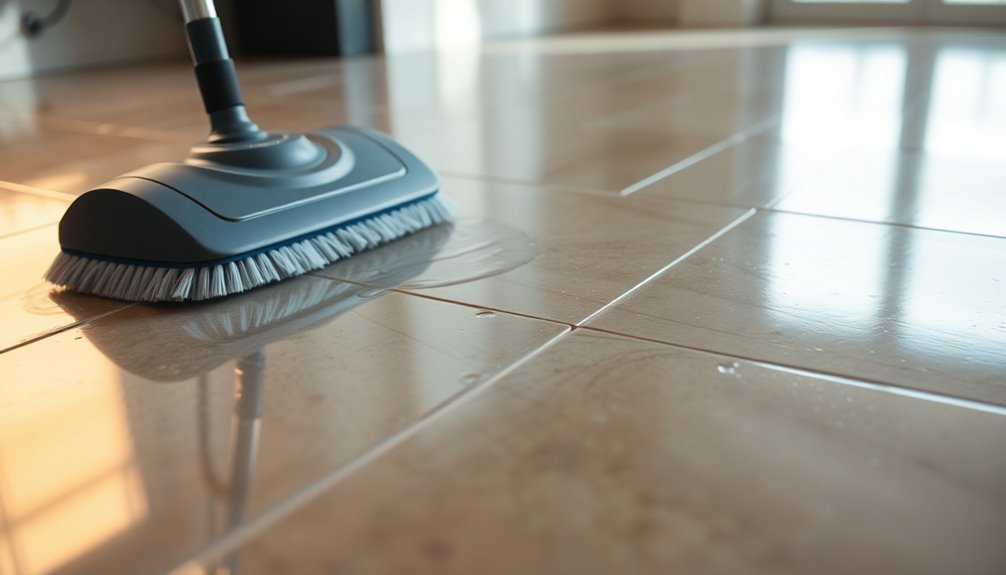
Have you ever wondered why your floor scrubber leaves streaks behind? It can be frustrating to see those unsightly marks after putting in the effort to clean. One of the primary culprits is often the squeegee blade. If it's dirty or damaged, it won't effectively remove water from the floor, leading to those dreaded streaks. Regularly inspecting the squeegee blade for wear and tear is crucial for maintaining your cleaner's performance.
Another factor to consider is the accumulation of dust and debris on your scrubber's components. If the squeegee frame or scrubber skirt is gunked up, it can drastically reduce water pickup, which contributes to streaking. Make it a habit to keep these areas clean, as a little maintenance goes a long way in enhancing your machine's efficiency.
You might also want to look at the condition of your floors. Low spots or uneven surfaces can hinder the squeegee's ability to maintain proper contact with the ground, which is essential for effective cleaning. The lack of contact means that water won't be picked up uniformly, leading to streaks. If you notice uneven areas on the floor, consider addressing those before using your scrubber.
Equally important is the adjustment of the squeegee itself. If its angle or deflection isn't set correctly, it can negatively impact cleaning efficiency and create those annoying streaks. Take a moment to check your machine's manual for the recommended settings and make any necessary adjustments.
Don't overlook the solution tank, either. If the cleaning solution is too diluted or too concentrated, it can affect how well your floor scrubber performs. Finding the right balance won't only improve your cleaning efficiency but also minimize streak formation.
Lastly, regular maintenance is key to preventing streaks. Make sure to empty the debris tray frequently to avoid clogs that could hinder performance.
Frequently Asked Questions
Why Is Floor Scrubber Leaving Streaks?
If your floor scrubber's leaving streaks, check a few things.
First, ensure there's no dust or hair caught between the squeegee and the floor. Uneven surfaces can also disrupt suction, causing streaks.
Inspect the squeegee blade for wear; if it's damaged, it won't pick up water effectively.
Regularly clean the squeegee and scrub deck, and try adjusting the squeegee angle or pressure to enhance contact and improve cleaning efficiency.
Why Is My Floor Scrubber Not Picking up All the Water?
Is your floor scrubber struggling to pick up all that water? You might be facing a few culprits.
Check those squeegee blades—they could be worn out or damaged.
Also, make sure your recovery tank isn't overflowing, as that can really hinder performance.
Don't forget to inspect the vacuum hose for clogs or leaks, too.
Regular maintenance is key to keeping everything running smoothly and ensuring you get the best results every time!
Why Does My Floor Cleaner Leave Streaks?
When you're using your floor cleaner, streaks can appear for several reasons.
Check if the squeegee has debris stuck to it, as this can block water pickup.
Inspect the front scrubber skirt for dust bunnies and ensure the squeegee frame is properly adjusted.
If you notice low spots on the floor, they might be causing suction issues.
Regular maintenance, including checking squeegee blades, will help keep your floors streak-free.
How Do You Unclog a Floor Scrubber?
To unclog your floor scrubber, start by inspecting the vacuum hose for any obstructions and remove them with a broom handle.
Next, check the squeegee assembly for blockages and clean it thoroughly.
Examine the solution tank and hoses for clogs, flushing them with warm water if needed.
Don't forget to empty the debris tray regularly.
If you still face issues, consult the operator manual or get professional help for deeper problems.
Conclusion
If your floor scrubber is leaving streaks, it's crucial to identify the underlying issue. It could be anything from dirty pads to the wrong cleaning solution. Wouldn't it be great to have sparkling floors without the hassle? Regular maintenance and the right techniques can make a world of difference. Take a moment to inspect your equipment, and you'll be on your way to achieving that spotless shine you desire!

